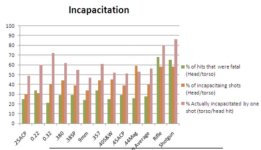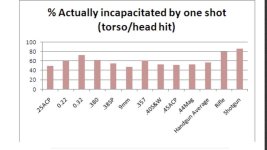Perhaps the only way to get real answers would be to set up a modern version of the Thompson / LaGarde testing originally done around the turn of last century on goats and pigs, only with better control and data collection. I doubt that would fly today with groups like PETA. Probably have a hard time getting enough human volunteers.
So, instead, we combine personal experience, what we have read or seen, personal likes and dislikes, and what passes for common sense when we pick a self defense handgun.
And the most effective choice ends up being simply having a handgun with you, and your potential attacker being so informed. Can't quote any specific statistics, but my "experience" (see above factors) after a long LE career, is that in the vast majority of cases, a potential attacker will beat feet when he becomes aware his intended victim is holding a firearm in his hand, and is willing to use it. Without a shot being fired.
The rare outlier is the thug who, for whatever reason, decides to risk death and continue the attack. That's when your willingness to use whatever you are carrying, to hit center mass, and to be willing to keep firing until the threat is down is what will save your bacon, with caliber and bullet brand becoming distant secondary considerations. JMHO.
Larry




